In Part I of our EV blog series, (posted Jan. 2, 2015), we learned that electric vehicles and hybrids aren’t new and have, in fact, become a widely accepted choice of transport for many Americans.
But what is the science behind how they work, what are the challenges in making them better, and what will be the impacts be on our nation’s infrastructure and environment?
Mission Possible – Improving Battery and Motor Technology and Range:
It is well established that the greatest challenge to deploying more electric vehicles is their relatively limited range. Range, or the distance that you can travel before having to stop to recharge your batteries, is determined by two factors: the efficiency of the power train (what is your equivalent MPG?) and the energy capacity of the battery bank (how big is your energy “tank”?). Let’s look first at the power train.
The image below reveals the powertrain components of a Ford Focus Electric. Visible are the battery pack, electric motor, regenerative braking components, and controller.
Engineers have made great strides in designing electric motors that get the most work done under the greatest range of circumstances, like low speed and high speed driving, or in hot and cold temperatures. These motors need to use energy sparingly, despite the circumstances that can inhibit their performance. Computerized controllers measure variables including torque, load, RPM, battery and motor temperature, voltage, and current and battery condition, and make sure that maximum performance and efficiency are achieved at all times. To get even more out of each bit of the car’s stored electrical energy, regenerative braking and coasting technologies are put to work.
The regenerative braking system is engaged with slight pressure on the brake pedal. Instead of engaging the traditional disk or drum brakes, which convert motion energy into useless heat, regenerative braking uses the car’s motor in reverse. The motor becomes a generator converting motion into electrical energy and the car slows. When greater braking force is needed and you apply more pressure on the brake pedal, the drum or disk brakes are engaged.
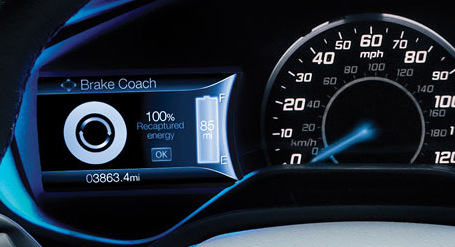
Above: Some Ford models include a “Brake Coach” to help drivers recover energy while braking.
Photo: electronicdesign.com
Regenerative coasting works in a similar fashion. When you’re on a long downhill road with your foot off the accelerator, the controller will prevent you from reaching too high a speed by engaging the motor as a generator and thus slowing you down. After a long downhill run, your battery will have more stored energy than when you were at the top of the hill!
Batteries, technology, and Range Wars!
Energy storage technology continues to improve and remains an area of constant research. The most common way to store energy is with batteries, but electric cars of the future might also use capacitors, which are able to store and discharge electrical energy much more quickly. Even hydrogen is a way to store energy onboard an electric vehicle. A Hydrogen Fuel Cell Vehicle is basically an EV that uses hydrogen gas as the energy storage medium. The hydrogen fuel generates electricity in combination with atmospheric oxygen as it passes through fuel cells. Water vapor is the resultant “exhaust”. Hydrogen fuel cell cars need a different refueling technology than battery electric vehicles (BEVs), so we’ll save that discussion for another day.
Early BEVs like the General Motors EV1 released in 1996 used heavy lead-acid batteries. Manufacturers soon looked for lighter, more energy-dense, solutions like nickel–metal hydride batteries that are used in the Toyota Prius as well as in other hybrids and EVs. Tesla was the first to introduce the use of lithium-ion batteries, and with these was the first BEV to travel more than 200 miles on a single charge.
Manufacturers and scientists are hot on the trail of new technologies that seek to multiply the energy-storage capacity of batteries by as much as seven times! This would mean that a Nissan Leaf could travel over 500 miles instead of 84, and the 265-mile range of a Tesla Model S would exceed 1,800 miles!
Desirable battery characteristics for electric vehicles include:
• High specific energy, or energy storage capacity
• High specific power, or the ability to provide high current on demand
• Long lifespan, or the ability to last for several years and through thousands of charging cycles
• Performance that’s not greatly affected by temperature, charge levels, and other conditions
• Low material and manufacturing costs
• Low weight-to-capacity ratio
Learn more about EV batteries at the US Department of Energy office of Energy Efficiency and Renewable Energy, EERE, page: http://www.afdc.energy.gov/vehicles/electric_batteries.html
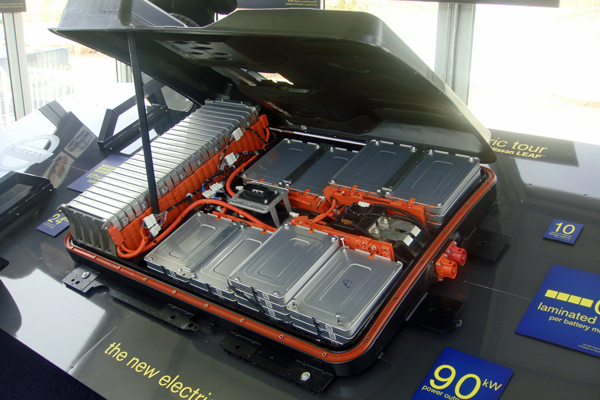
Above: Lithium-ion battery pack for a Nissan Leaf.
Photo: Wikimedia commons, Mariordo Mario Roberto Duran Ortiz
Recent strides in battery technology make the news every day. One week into the New Year, at the 2015 Detroit Auto Show, Chevrolet unveiled their concept car the Chevy Bolt. Not to be confused with its plug in series hybrid with onboard gas generator, the Volt, Chevy’s newest creation promises 200-mile all-electric range and a price tag under $30,000. One week after the announcement of this affordable, longer range EV, Nissan announced plans for a similar offering that will take their Leaf from an 84-mile range to 200 miles. Consumers can expect to be big winners in the electric vehicle Range Wars!
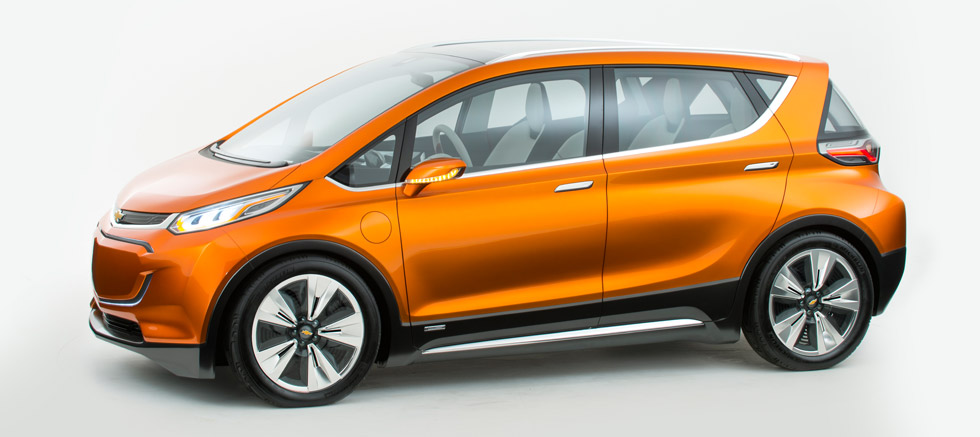
Above: the Chevy Bolt electric vehicle, due in 2017.
Photo: Chevrolet
It’s hard to understate the impact that new battery types are likely to have on the industry. Tackling the limited range associated with EVs is, after all, one of the two big hurdles along with the time it takes to recharge whichever battery design is in use. The other hurdle is having enough places to charge and competing with gas and diesel for quick refueling.
“Charge!” or, “Fill ‘er up!” What to do when you run low on energy:
Even after we reach a point where all EVs can manage a 500-mile trip on one charge, there’s the problem of how long it takes to “refill” that battery pack! One of the convenient features of EVs, that every electrical outlet is a potential recharging point, also points to a drawback: typical household 120 Volt AC power outlets can take as many as 8 hours to recharge a depleted battery. For many drivers, however, this won’t be a problem. First, your battery might be at 80% charge and not need a full 8 hours. And second, if you have a home charger you can just plug it in every night and have a full charge the next morning. Increasingly, people are finding that they can also charge at work.
More and more government agencies and businesses are installing EV charging points, and the U.S. Department of Energy is encouraging expansion of workplace charging with the “EV Everywhere Workplace Challenge: http://energy.gov/eere/vehicles/ev-everywhere-workplace-charging-challenge
All Charged Up!
Like the various battery designs we’ve seen come and go, charging technologies and connection designs are under constant development and change. The charging stations and connectors used in the 1990s have been scrapped in favor of new standardized plugs and sockets that work for multiple manufacturers’ models. There are currently three types of charging levels that are commonly available:
AC Level I charging uses standard household 120 Volt AC power. Eight hours of charging provides about 40 miles of travel, 30% further than the average daily distance driven by American owners.
AC Level II charging doubles the voltage to 240 Volts and increases the current to between 20 and 100 amps. Most homes have 240 volts available and are candidates for Level II charging systems, which provide 10 to 20 miles of range for one hour of charging time.
DC Fast Charging, often called DC Level II, is the fastest charging technology currently available and delivers direct current at rates that can add 50 to 70 miles of range in just 20 minutes. DC Fast Chargers are found at key points along major highways, and at airports and malls but are not typically installed at home. The car must be equipped to use this method; it is not always a standard feature.
Helping to meet the need for and interest in fast charging are two major companies: Tesla and NRG. To help Tesla owners keep their cars rolling, the company has installed 354 Supercharger stations and 1,936 Superchargers globally, and they’re adding an additional two chargers per week in new locations. That’s terrific if you own a Tesla, but don’t expect to charge your Nissan Leaf at a supercharger.
NRG Energy is a major player in the power generation sector and one of NEED’s partners in energy education. In addition to generating tons of energy that’s sold to utility companies, NRG also has a home solar division and a growing network of car charging solutions under the name “eVgo”. NRG eVgo provides charging solutions for homes or businesses. When you’re away from home or work, look for eVgo Freedom Stations®, public stations with Level 2 and DC fast chargers.
Future AC Charging, Inductive Charging, and Battery Swapping:
If you drive a newer Tesla, you can get a fast charge at a Tesla Superstation but other manufacturer’s cars can’t access these options. Other EVs, like the Ford Energi models, use a different DC fast charging interface. The electric vehicle market is dynamic and the competing charging schemes will hopefully come together in the near future. Development is underway to create new standards for high-voltage, conductive, three-phase AC charging systems that utilize the AC power you might associate with large transmission lines. These charging systems would not be compatible with the typical home because of the high power requirements. Commercial and industrial locations where the power already exists would be the easiest places to install these. Current DC fast charging and most domestic, or household, fast chargers are conductive charging solutions, meaning they use cords or cables to transmit the power.
Many owners dislike having to physically take a cord out and plug it into their car every day, so an alternative approach has been developed. Inductive charging uses no cables; power is transmitted without a physical connection! Inductive charging uses an electromagnetic field to transmit power to the device being charged. Electric toothbrushes and many other cordless rechargeable household appliances use inductive charging. Currently, this technology is only being used in commercial applications, including a growing number of fast-charge public transit system electric buses. A growing number of public transit districts from Seattle, WA to Louisville, KY are adding inductive-charging electric buses to their fleets. Currently limited to commercial applications, SAE International is developing a standard that may apply to personal EVs in the future.
Proterra is just one of many companies that offer bus models with this inductive charging technology. When the bus parks under a dedicated charger, 500kW of power is transferred inductively. Ten minutes of charge can provide 20 to 30 miles of travel.
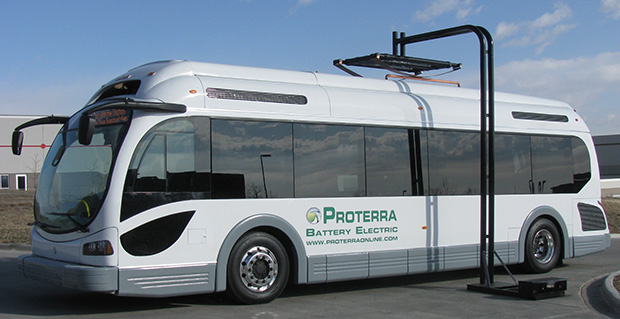
Above: One of Proterra’s battery electric buses taking on an inductive charge.
Photo: Proterra
“Battery Swapping” might be a solution for long-distance travel where fast chargers aren’t available. Cars equipped with standardized battery packs would pull into a participating station and have their depleted battery pulled out and replaced with a fully charged one in less time than it takes to fill and tank with gasoline.
For more information about current and developing charging technologies, visit the U.S. Department of Energy’s EERE Alternative Fuels Data Center:
http://www.afdc.energy.gov/fuels/electricity_infrastructure.html
“But Electric Vehicles just run on electricity that comes from burning fossil fuels, right?”
No, that’s not quite right. The answer depends upon the “Energy Mix” for the electric utility providing the electricity. Most utility companies provide electricity generated using a combination of several renewable and non-renewable energy sources. “Energy Mix” or “Fuel Mix” refers to the proportions of each source for that provider. In the Pacific Northwest, providers have a lot of hydroelectric power available, so an electric vehicle might be predominantly powered by hydropower, with some natural gas, coal, and other sources in the mix. Take Washington State, for example, noting the data below from Washington’s Department of Commerce:
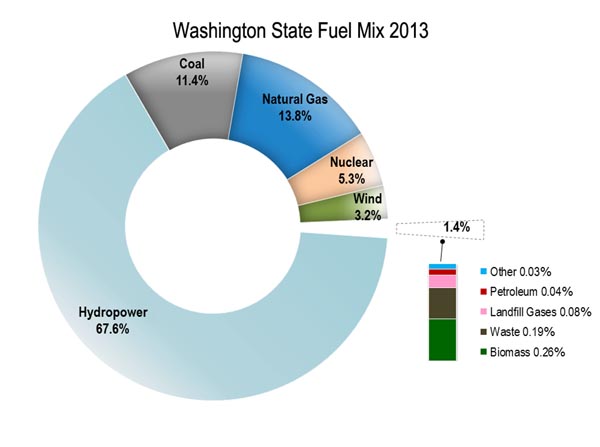
However, if you’re using electricity in the state of Florida or New York for example, you’ll be running indirectly on a mix that includes a lot of natural gas generation. In short, it depends on where you buy your power.
The US Department of Energy’s Energy Information Administration, EIA, website contains detailed data for every state: http://www.eia.gov/state/
It’s important to know that even if your utility company is dependent of fossil fuels like coal and natural gas as sources, in most cities the greenhouse gas emissions impact from an electric vehicle using that power is lower than a similar vehicle using gasoline or diesel. Visit the EERE Alternative Fuels Data Center page to determine the emissions profile for power generated in your community: http://www.afdc.energy.gov/vehicles/electric_emissions.php
“Wait. Where is all the power coming from? Do we even have that much electricity?”
For generations, our primary vehicular fuel, gasoline, has been a completely separate commodity from the fuels used to provide our electricity. While it might be a very good thing to shift to cleaner cars and become less dependent petroleum imports, shifting to electrical power will have significant impacts on electric utility providers and the electrical transmission and distribution infrastructure we call “the grid”.
The lines in the graphic below connecting the primary energy sources on the left with the demand sectors on the right summarize the links between energy sources and sectors in the United States. For example, 100% of nuclear energy is used in the electric power sector to generate electricity, and 71% petroleum is used in the transportation sector.
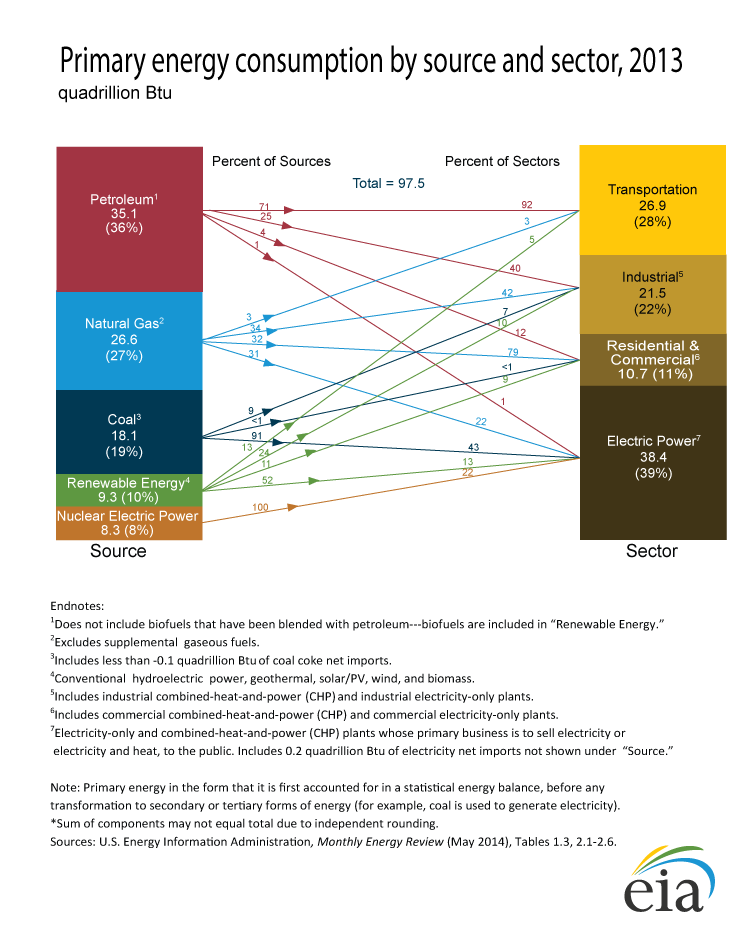
Currently, petroleum fuels meet most of our transportation needs. As we shift to electrified transportation, less petroleum will be used but more electricity will need to be generated
Let’s suppose that we wanted to convert the entire U.S. fleet of gasoline-powered vehicles to electric power. In 2012, Americans used about 133 billion gallons of gasoline. Each gallon has a thermal energy content of roughly 33.41 kWh. This means the gasoline used that year had a total thermal energy content of 4,444 TWh, or terawatt-hours. Fortunately, we don’t need to generate that much additional electricity. Most of the potential thermal energy in gasoline isn’t transformed into motion; it’s lost as heat or wasted while the vehicle is idling, or not completely burned. The comparative efficiency of electric motors means we might only need to generate a fourth as much energy or an additional 1,111 TWh of electric power.
The total consumption of electricity in the US in the same year was 4,047 TWh. The additional 1,111 TWh we might need to generate represents about a 27% increase, but not all at once. Bringing that much power online all at once, or even in one or two years, would be impossible and, thankfully, we won’t need to act that quickly. Our gradual shift from petroleum to electricity for transportation needs will allow us time to find solutions to the challenge of producing more energy.
Is all this change worth the effort?
Electric transportation is quiet and efficient, the vehicles require much less maintenance, and the infrastructure for charging is already in place, though improvements are needed. But you might wonder if it’s worth the cost and effort to make the change. The cost per mile of driving an electric vehicle compares very favorably to the cost of gas or diesel transportation:
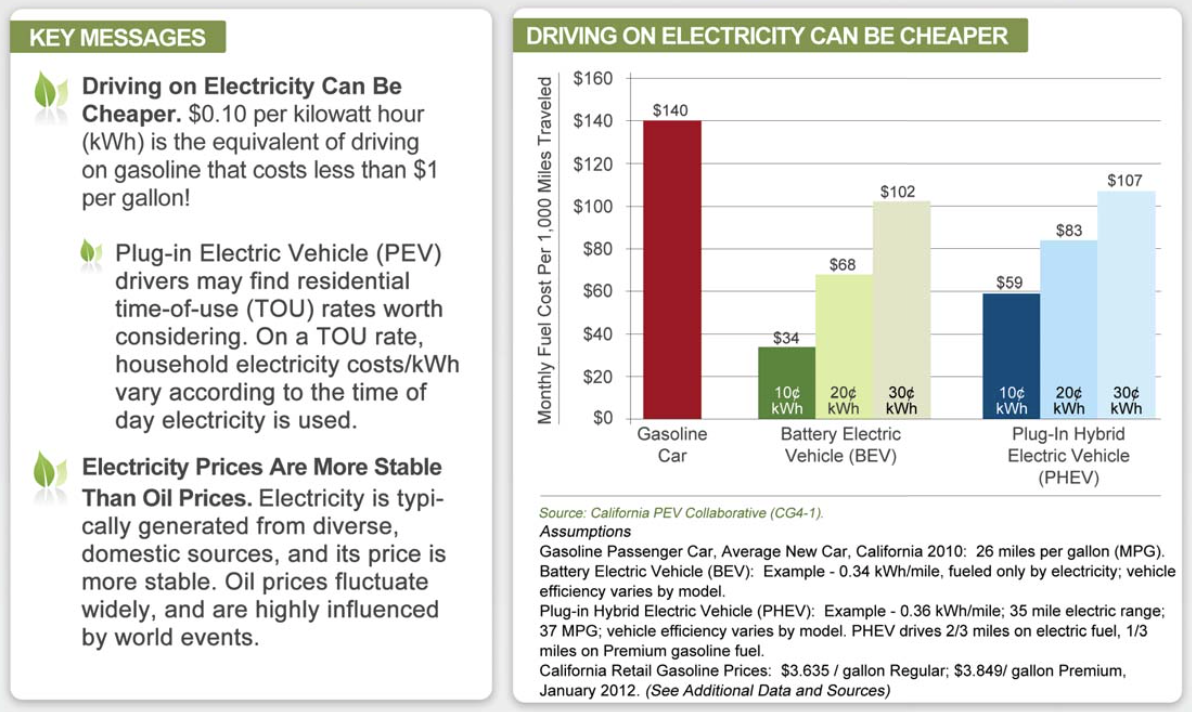
Electric Vehicles and the Grid – Mutual Benefits:
At first glance, the demand that growing numbers of EVs will have on the grid might seem like a problem, but both industries stand to share a number of benefits. First, the U.S. electricity generation and transmission sector has been actively looking for ways integrate more grid-scale energy storage technologies that will help providers meet variable demand for electricity and deploy more energy generated by intermittent renewable sources like wind and solar. New battery technologies, the same being developed for electric vehicles, could lead to solutions that will provide more stored capacity for the grid.
Transportation and Generation: Come Together!
Another way that the electric vehicle revolution can help electricity providers meet demand for reliable and clean power is through an energy infrastructure innovation called “Vehicle to Grid”, or V2G. Ordinarily, power goes in one direction: from the grid to electric vehicles’ batteries. But as more and more EVs come online, it becomes possible to imagine the tens of thousands of battery banks working together as one big energy storage bank that utility providers can use at times of high demand. Under a V2G scenario, EV owners would plug into metered charging stations that allow energy to go in both directions: charging the battery packs with energy from the grid AND sending energy back to the grid at times when it’s when it’s needed. The grid would return the power to the cars when supplies are plentiful, especially from renewables like wind and solar. Participating EV owners pay for the electricity they use and would be credited for any energy they provide. As the technology for two-way power transfer using electric vehicles matures, expect to see other applications, like Vehicle-to-Home, allowing your house to borrow power from your car during power outages, Vehicle-to-Vehicle to provide a boost from charged vehicles to vehicles in need of a charge.
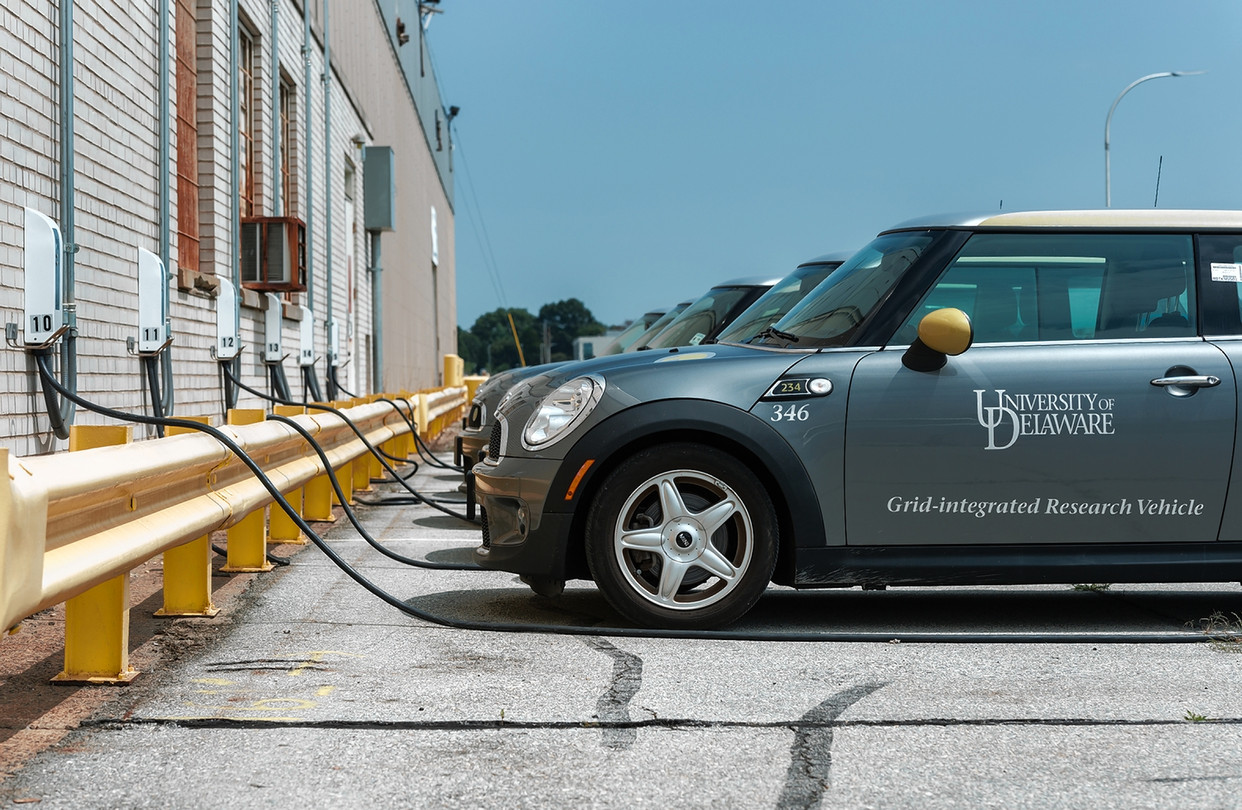
The University of Delaware’s Grid-Integrated V2G research project is one of many programs investigating ways that EVs can work with the electrical power grid.
Consistent with their mission to reduce energy costs, decrease reliance on foreign oil, ensure energy security, and achieve sustainability goals, the U.S. Department of Defense (DOD), launched the world’s biggest V2G fleet last year.
In cooperation with utility provider Southern California Edison, the California Energy Commission, and others, Los Angeles Air Force Base in El Segundo, Calif., announced plans to replace its entire general-purpose fleet with plug-in electric vehicles during a media event on Nov. 14, 2014. The base’s electric vehicle fleet consisting of 42 vehicles, including sedans, pick-up trucks and mini vans, of which 36 will be V2G-capable, is the largest operational V2G demonstration in the world.
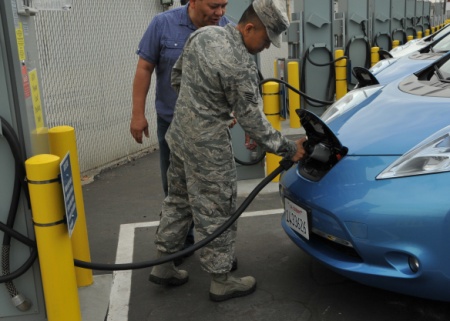
U.S. Air Force photo by Sarah Corrice/Released
“Everything we do to fly, fight and win requires energy, whether it’s aviation fuel for our aircraft
or power to run the bases that support them,” said Secretary of the Air Force Deborah Lee
James. “This vehicle-to-grid pilot is a great example of how Airmen are driving the Air Force
forward and finding new and innovative ways to make every dollar count.”
Read more about the DOD V2G project here:
http://science.dodlive.mil/2014/11/21/the-air-forces-plug-in-vehicle-fleet/
OK, I’m convinced. Electrified transportation is here to stay. Now what?
As more and more cars, trucks, and even buses hit the highways it’s becoming crystal clear: Electric vehicles are here to stay!
In our next installment, learn how to shop for an Electric Vehicle!
Part II: Emerging Technologies, The Grid, and Implications for the Future
